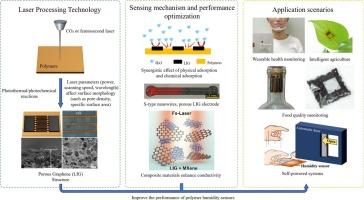湿度传感器用激光加工聚合物及其应用
IF 6.3
2区 化学
Q1 POLYMER SCIENCE
引用次数: 0
摘要
湿度传感器广泛应用于环境监测、医疗保健、农业和工业等领域。其性能的提高依赖于材料和制备技术的创新。传统的湿度传感器存在响应慢、机械脆性和灵敏度有限等问题,而聚合物材料由于其灵活性和可加工性而成为理想的替代品。近年来,激光加工技术通过高精度、无掩模、绿色、高效的微纳结构制备方法,给聚合物湿度传感器带来了革命性的进步。本文系统阐述了激光加工聚合物湿度传感器的材料体系、制备工艺、传感机理和性能优化策略,重点分析了激光诱导多孔结构、功能修饰和工艺参数调节对传感器灵敏度、响应速度和稳定性的增强作用。此外,综述了该类传感器在可穿戴健康监测、智慧农业、食品质量监测等领域的实际应用,并展望了自供电、多模态集成、可降解材料等未来的研究方向。通过全面梳理“材料-工艺-性能-应用”之间的内在联系,旨在为高性能、柔性、绿色、可持续的湿度传感器的设计和产业化提供理论参考和应用指导。本文章由计算机程序翻译,如有差异,请以英文原文为准。

Laser-processed polymers for humidity sensors and the application
Humidity sensors are widely used in fields such as environmental monitoring, healthcare, agriculture, and industry. Their performance improvement relies on innovations in materials and preparation technologies. Traditional humidity sensors have problems such as slow response, mechanical brittleness, and limited sensitivity, while polymer materials have become ideal alternatives due to their flexibility and processability. In recent years, laser processing technology has brought revolutionary progress to polymer humidity sensors through high-precision, mask-free, green and efficient micro-nano structure preparation methods. This review systematically elaborates on the material systems, preparation processes, sensing mechanisms, and performance optimization strategies of laser-processed polymer humidity sensors, with a focus on analyzing the enhancing effects of laser-induced porous structures, functional modification, and process parameter regulation on the sensitivity, response speed, and stability of the sensors. In addition, the review discusses the practical applications of such sensors in fields such as wearable health monitoring, smart agriculture, and food quality monitoring, and looks forward to future research directions such as self-powered, multi-modal integration, and degradable materials. By comprehensively sorting out the intrinsic connections between “materials − processes − performance − applications”, this review aims to provide theoretical references and application guidance for the design and industrialization of high-performance, flexible, green and sustainable humidity sensors.
求助全文
通过发布文献求助,成功后即可免费获取论文全文。
去求助
来源期刊

European Polymer Journal
化学-高分子科学
CiteScore
9.90
自引率
10.00%
发文量
691
审稿时长
23 days
期刊介绍:
European Polymer Journal is dedicated to publishing work on fundamental and applied polymer chemistry and macromolecular materials. The journal covers all aspects of polymer synthesis, including polymerization mechanisms and chemical functional transformations, with a focus on novel polymers and the relationships between molecular structure and polymer properties. In addition, we welcome submissions on bio-based or renewable polymers, stimuli-responsive systems and polymer bio-hybrids. European Polymer Journal also publishes research on the biomedical application of polymers, including drug delivery and regenerative medicine. The main scope is covered but not limited to the following core research areas:
Polymer synthesis and functionalization
• Novel synthetic routes for polymerization, functional modification, controlled/living polymerization and precision polymers.
Stimuli-responsive polymers
• Including shape memory and self-healing polymers.
Supramolecular polymers and self-assembly
• Molecular recognition and higher order polymer structures.
Renewable and sustainable polymers
• Bio-based, biodegradable and anti-microbial polymers and polymeric bio-nanocomposites.
Polymers at interfaces and surfaces
• Chemistry and engineering of surfaces with biological relevance, including patterning, antifouling polymers and polymers for membrane applications.
Biomedical applications and nanomedicine
• Polymers for regenerative medicine, drug delivery molecular release and gene therapy
The scope of European Polymer Journal no longer includes Polymer Physics.
 求助内容:
求助内容: 应助结果提醒方式:
应助结果提醒方式:


